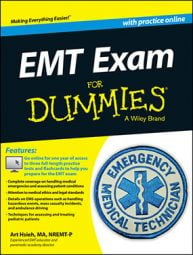You will need to know about the nervous system for the EMT exam. Simplistically, the nervous system serves a command and control purpose, primarily by receiving signals from nerves throughout the body, passing them through the spinal cord, processing those signals in the brain, and communicating some type of change in response.
Of course, we’re much more than just a bunch of signals moving back and forth. The human brain — which gives people the ability to have conscious thought and engage with our environment in a purposeful, deliberate way — is what makes humans stand out from most of the animal kingdom.
The human brain is much bigger proportionally to the body compared to most other mammals. It requires a lot of oxygen and nutrients, such as glucose, to function effectively. That’s the reason why EMTs evaluate mental status early and often — even simply being sleepy may be an early indication of an oxygenation, ventilation, or circulation issue.
The brain is also sensitive to changes in chemistry, ranging from disease processes like hyperglycemia that causes increased acidity in the blood (diabetic ketoacidosis) to recreational drugs such as alcohol, marijuana, and 3-4 methylenedioxymethamphetamine (MDMA, also known as Ecstasy or Molly). Checking for orientation status — awareness of person, place, time, and event — gives you a more precise understanding of how affected the brain is in these situations.
![[Credit: Illustration by Kathryn Born, MA]](https://www.dummies.com/wp-content/uploads/439678.image0.jpg)
Because the nervous system can be affected by so many factors, coming up with a full list of conditions that affect it is difficult. However, there are a few illnesses specific to the nervous system that you should recognize quickly and treat.
| Problem | Signs and Symptoms | Action Steps |
|---|---|---|
| Headache | Non–life-threatening conditions such as tension headache
or migraine: Generalized discomfort ranging from dull and throbbing
to sharp in nature. May be global or focused on one side. May have
associated nausea, vomiting. Life-threatening conditions such as hemorrhagic stroke: Rapid onset, severe pain. Projectile vomiting resulting from increased cerebral pressure. Contagious, serious illnesses such as meningitis: May have fever, light sensitivity, vomiting, stiff neck. |
Provide quiet, darkened environment. Manage airway: Suction secretions, ventilate with bag-valve mask if needed. Meningitis can be very contagious, spreading through airborne droplets. Wear a HEPA mask and protective eyewear along with gloves if suspected. |
| SeizureStatus epilepticus | Generalized seizure: Patient may experience initial aura
(flashing lights, strong smell or taste), then a loss of
consciousness, followed by intense twitching of all muscles lasting
a few seconds to a minute. May have incontinence or bite tongue.
Afterwards, enters post ictal period where patient is unresponsive
and difficult to arouse. May not remember episode after
awakening. Localized seizure: No loss of consciousness but may not be aware of seizure occurring. Involuntary twitching is focused in one part of the body. Status epilepticus: Prolonged generalized seizure or nonstop seizures without regaining consciousness in between episodes. This is a major medical emergency. |
If seizing, protect the patient from further harm by moving
furniture and other items away and padding between the patient's
head and surface. As soon as seizure ends, control airway and clear oral secretions. Reassure patient as post ictal period ends. If status seizures, ventilate as best as possible and transport immediately. |
| Stroke: Ischemic stroke: Blockage of an artery in the brainHemorrhagic stroke: Sudden bleeding in the brainTransient ischemic attack (TIA): A stroke lasting less than 24 hours |
Sudden onset of weakness on one side of the body. Facial drooping, difficulty swallowing. Blurred or loss of vision in one eye. Confusion, weakness, dizziness, coma.Sudden, severe headache (more related to hemorrhagic stroke). Speech that’s garbled (can’t be understood) or nonsensical (clear but makes no sense). |
Evaluate using Cincinnati stroke scale.Check blood glucose
levels. Maintain airway patency via suctioning, positioning. Administer supplemental oxygen if you see signs of hypoxia. Determine when symptoms began. If patient awoke from sleep, time starts when patient fell asleep.If you can’t tell whether you’re dealing with TIA or stroke, assume stroke until proven otherwise. If possible, transport to hospital specializing in stroke care. |
A mnemonic, AEIOUTIPS, can be used to quickly remember a variety of conditions that can cause altered mental status. Use it when you’re asked to determine the underlying cause of a patient’s altered mental status. It stands for
A: Alcohol ingestion
E: Epilepsy
I: Infections such as meningitis or sepsis
O: Drug overdoses
U: Uremia of the blood, or kidney failure
T: Trauma to the brain
I: Insulin, or diabetic emergencies
P: Psychiatric emergencies
S: Stroke
A 50-year-old male is unresponsive to a sternal rub. His skin is pale and dry. His blood pressure is 140/86 mm Hg. He is breathing 6 times per minute, with shallow effort, and his lungs sound clear. He has a history of hypertension and diabetes, and recently returned home from the hospital, where doctors repaired a fractured right hip. His medications include an antihypertensive, insulin, and a narcotic painkiller.
Which of the following procedures would help you determine the cause of his presentation?
(A)Check for facial symmetry and hand grip strength.
(B)Inspect pupils for size and symmetry.
(C)Inspect the abdomen for injection marks.
(D)Palpate to see whether the surgical site on the hip is painful.
The correct answer is Choice (B). For this patient, AEIOUTIPS provides you with several suspicious possibilities: stroke (hypertension), overdose (narcotic), and insulin or diabetic emergency (patient history). Looking more closely at the information provided, you can see that his slow, shallow breaths may be a result of a narcotic overdose.
Choice (B) can help you determine whether his pupils are constricted, which helps to validate that suspicion. You’re unable to perform a Cincinnati stroke test, as Choice (A) suggests, because he is unresponsive. Performing the other choices may provide you information, but won’t help you determine the underlying cause of the presentation.

